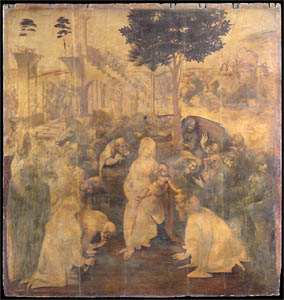1245.
THE ELEPHANT.
The huge elephant has by nature what is rarely found in man; that is
Honesty, Prudence, Justice, and the Observance of Religion; inasmuch
as when the moon is new, these beasts go down to the rivers, and
there, solemnly cleansing themselves, they bathe, and so, having
saluted the planet, return to the woods. And when they are ill,
being laid down, they fling up plants towards Heaven as though they
would offer sacrifice. --They bury their tusks when they fall out
from old age.--Of these two tusks they use one to dig up roots for
food; but they save the point of the other for fighting with; when
they are taken by hunters and when worn out by fatigue, they dig up
these buried tusks and ransom themselves.
1246.
They are merciful, and know the dangers, and if one finds a man
alone and lost, he kindly puts him back in the road he has missed,
if he finds the footprints of the man before the man himself. It
dreads betrayal, so it stops and blows, pointing it out to the other
elephants who form in a troop and go warily.
These beasts always go in troops, and the oldest goes in front and
the second in age remains the last, and thus they enclose the troop.
Out of shame they pair only at night and secretly, nor do they then
rejoin the herd but first bathe in the river. The females do not
fight as with other animals; and it is so merciful that it is most
unwilling by nature ever to hurt those weaker than itself. And if it
meets in the middle of its way a flock of sheep
1247.
it puts them aside with its trunk, so as not to trample them under
foot; and it never hurts any thing unless when provoked. When one
has fallen into a pit the others fill up the pit with branches,
earth and stones, thus raising the bottom that he may easily get
out. They greatly dread the noise of swine and fly in confusion,
doing no less harm then, with their feet, to their own kind than to
the enemy. They delight in rivers and are always wandering about
near them, though on account of their great weight they cannot swim.
They devour stones, and the trunks of trees are their favourite
food. They have a horror of rats. Flies delight in their smell and
settle on their back, and the beast scrapes its skin making its
folds even and kills them.
1248.
When they cross rivers they send their young ones up against the
stream of the water; thus, being set towards the fall, they break
the united current of the water so that the current does not carry
them away. The dragon flings itself under the elephant's body, and
with its tail it ties its legs; with its wings and with its arms it
also clings round its ribs and cuts its throat with its teeth, and
the elephant falls upon it and the dragon is burst. Thus, in its
death it is revenged on its foe.
1245 [Humorous Writings.] (Notebooks of Leonardo da Vinci)
 YouTube - Adoration of the Magi - Pr. Seracini video
YouTube - Adoration of the Magi - Pr. Seracini video
Leonardo da Vinci
Adoration of the Magi
1481
Charcoal and white lead over plaster priming on wood (h. 243 cm, w. 246 cm)
Galleria degli Uffizi, Florence inv. 1890, n. 1594
Recent diagnostic investigations on Leonardo da Vinci’s the Adoration of the Magi, conducted by Maurizio Seracini, have revealed that the painting was carried out in two distinct stages, during two different time periods (a).
During the first stage Leonardo applied, on a panel made of an assembly of ten poplar planks (b), a ground consisting of layers of coarse and fine gesso bound with animal glue (c). He then developed a detailed brush drawing with lamp black and natural resin. This was covered with a thin priming of lead white, transparent enough that the drawing would remain visible during the painting phase (d). The only area that Leonardo went on to paint substantially was the sky, which is made of a mixture of lead white and a little ultramarine. He also applied occasional highlights to some of the figures and parts of the architecture (e).
A second stage came much later, when another artist added several layers of paint made of red and brown earth pigments, copper resinate and a lot of charcoal in oil with some resin (f). These monochrome layers do not follow the lines of the underdrawing, instead largely obscure it.
In summary, Leonardo’s magnificent creative moment in the Adoration is represented by the superb preparatory drawing, which can once again be admired thanks to the results of scientific studies (g, h, i).
In the preparatory drawing on paper, Leonardo first traced the architecture and a large covered structure on top of meticulously-drawn lines of perspective (j). He then went on to fill in the scene with figures and horses, sketching first in charcoal and then adding greater detail with iron gall ink (k).
The Mind of Leonardo - The Universal Genius at Work: Institute and Museum of the History of Science
Leonardo ignored that:
 Elephants can swim quite well. Fogonazos: The swimming elephants
Elephants can swim quite well. Fogonazos: The swimming elephantsthe elephant crossing by leonardo da vinci & inneke 23
Extinction Blog: Elephant conservation too successful, culling to ...
"They may be conscious of suffering in other elephants, they may have a knowledge of the 'other' that puts them low down but on the path to some kind of self-consciousness. They are higher than most animals but lower than humans." ...
Plenty Magazine - Environmental... - http://plentymag.com/
♂◙○♀








No comments:
Post a Comment